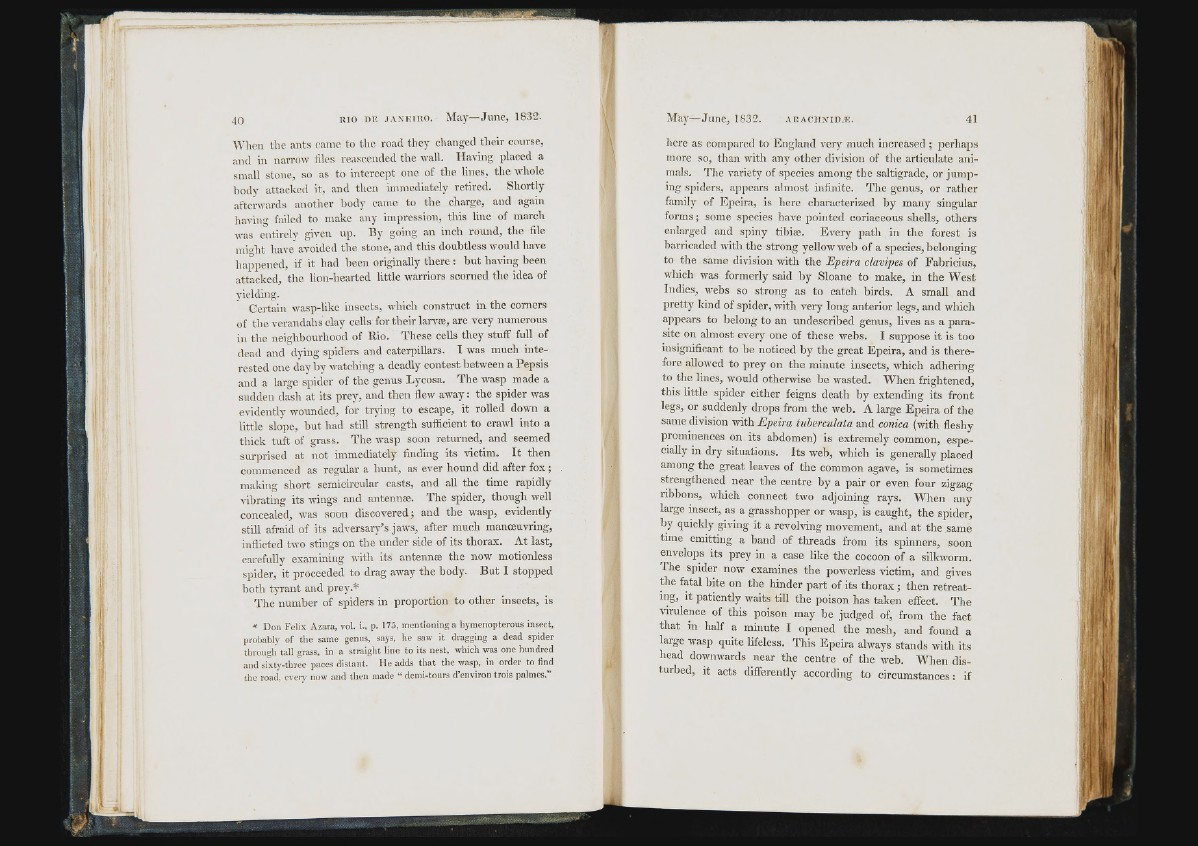
■to RIO DE JANEIRO. May—June, 18,32.
When the ants came to the road they changed their course,
and in narrow files reascendcd the wall. Having placed a
small stone, so as to intercept one of the lines, the whole
body attacked it, and then immediately retired. Shortly
afterwards another body came to the charge, and again
liaving failed to make any impression, this line of march
was entirely given up. By going an inch round, the file
miriit have avoided the stone, and this doubtless would have
happened, if it had been originally there : but having been
attacked, the lion-hearted little warriors scorned the idea of
yielding.
Certain wasp-like insects, which construct in the corners
of the verandahs clay cells for their larvæ, are very numerous
in the neighbourhood of Rio. These cells they stuff full of
dead and dying spiders and caterpillars. I was much interested
one day by watching a deadly contest between a Pepsis
and a large spider of the genus Lycosa. The wasp made a
sudden dash at its prey, and then flew away ; the spider was
evidently wounded, for trjring to escape, it rolled down a
little slope, but had still strength sufficient to crawl into a
thick tuft of grass. The wasp soon returned, and seemed
surprised at not immediately finding its victim. It then
commenced as regular a hunt, as ever hound did after fox ;
making short semicircular casts, and all the time rapidly
vibrating its wings and antennæ. The spider, though well
concealed, was soon discovered; and the wasp, evidently
still afraid of its adversary’s jaws, after much manoeuvring,
inflicted two stings on the under side of its thorax. At last,
carefully examining with its antennæ the now motionless
spider, it proceeded to drag away the body. But I stopped
both tyrant and prey.*
The number of spiders in proportion to other insects, is
* D o n F e lix A z a ra , vol. i., p. 175, m e n tio n in g a h ym e n o p te ro u s in se c t,
p ro b ab ly o f th e s am e g e n u s , says, h e saw i t d rag g in g a d e a d sp id e r
th ro u g h ta ll grass, in a s tr a ig h t lin e to its n e s t, w h ic h was o n e h u n d r e d
a n d s ix ty - th r e e p a c es d is ta n t. H e ad d s t h a t th e wasp , in o rd e r to find
th e ro ad , e v e ry now a n d th e n m ad e “ d em i-to u rs d’en v iro n tro is p a lm e s .”
May—June, 18.32. aracjinid.e .
here as compared to England very much increased ; perhaps,
more so, than with any other division of the articulate animals.
The variety of species among the saltigrade, or jumping
spiders, appears almost infinite. The genus, or rather
family of Epeira, is here characterized by many singular
forms ; some species have pointed coriaceous shells, others
enlarged and spiny tibiæ. Every path in the forest is
barricaded with the strong yellow web of a species, belonging
to the same division with the Epeira clavipes of Fabricius,
which was formerly said by Sloane to make, in the West
Indies, webs so strong as to catch birds. A small and
pretty kind of spider, with very long anterior legs, and which
appears to belong to an undescribed genus, lives as a parasite
on almost every one of these webs. I suppose it is too
insignificant to be noticed by the great Epeira, and is therefore
allowed to prey on the minute insects, which adhering
to the lines, would otherwise be wasted. When frightened,
this little spider either feigns death by extending its front
legs, or suddenly drops from the web. A large Epeira of the
same division with Epeira tuberculata and conica (with fleshy
prominences on its abdomen) is extremely common, especially
in dry situations. Its web, which is generally placed
among the great leaves of the common agave, is sometimes
strengthened near the centre by a pair or even four zigzag
ribbons, which connect two adjoining rays. When any
large insect, as a grasshopper or wasp, is caught, the spider,
by quickly giving it a revolving movement, and at the same
time emitting a band of threads from its spinners, soon
envelops its prey in a case like the cocoon of a silkworm.
The spider now examines the powerless victim, and gives
the fatal bfte on the hinder part of its thorax ; then retreating,
it patiently waits till the poison has taken effect. The
virulence of this poison may be judged of, from the fact
that in half a minute I opened the mesh, and found a
large wasp quite lifeless. This Epeira always stands with its
head downwards near the centre of the web. When disturbed,
it acts differently according to circumstances: if